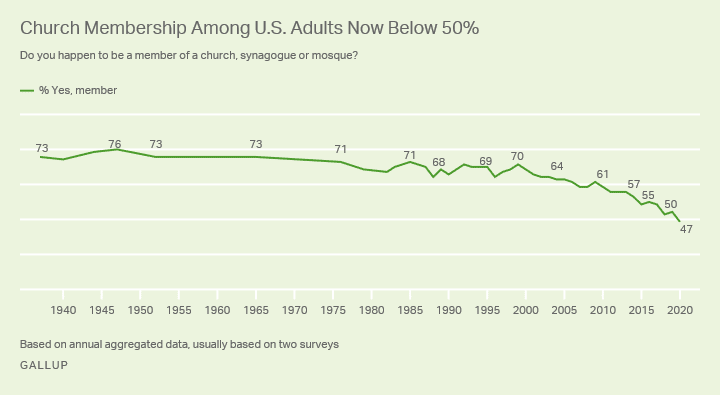Estimated reading time: 7 minutes
A friend shared with me some concerns about her church. The ministry has been around for 40-plus years, and the founding pastor still teaches.
He is a remarkable teacher of the Word. Members grow spiritually, and there are many great things about this church.
However, when you walk into the building, you feel like you are stepping back in time.
When you sit in this church (that has amazing spiritual teaching), there are empty pews. But primarily one demographic – people who have been with this church since its beginning. She knows this church has done a lot of great things but fears that the church is dying.
What causes a church to die?
Churches die for many reasons. Some of those reasons can be attributed to an overall decline in church attendance in the last few decades.
According to Gallop, church membership is down 20 points since 1999 because religious affiliation (those who claim relationships with church organizations) is down.

Between 1998 and 2000, an average of 73% of religious Americans belonged to a church, synagogue, or mosque. Over the past three years, the average has fallen to 60%.
While this is, at least in part, out of the control of churches, there are things that churches can do to keep their church alive.
How to keep a church from dying
Rick Warren (literally) wrote the book on church growth, and he states in The Purpose-Driven Church…… If a church is not growing, it is dying.
His point in this quote is that a church is a living thing that needs to be cared for and nurtured to continue to grow and not die.
A vibrant church utilizes 21st-century methods and technologies to present an unchanging message.
In other words, if churches want to survive our ever-changing world, they need to be able to relate to people in real time.
Let’s talk about a few examples.
Website
The internet is the new Yellow Pages when it comes to finding a church. People do a simple internet search, and churches near you appear in the feed.
Next, those same people click on the website to get a feel for the church. In other words, they are trying to determine if this church feels like a place that would be a good fit for their family.
A church website is a window into the church and should be current, accurate, and reflective of your church.
This includes an updated logo, content, and appealing images to a 21st-century audience.
Music
Churches use the worship part of a service to help usher in God’s presence and prepare its members for receiving His Word.
Today’s church needs to have music that is well-orchestrated and relatable. Hymns of old are great, but the delivery needs to be as professional as possible. If you don’t have talented musicians, use canned music to take it up a notch.
Music should never be the primary part of the service, but it is important.
What draws new members?
People choose churches based on personal interests and spiritual needs.
According to Gallop, spiritual programs geared toward children and teenagers, community outreach and volunteer opportunities, and dynamic leaders also influenced their attendance.
8 Things To Consider If You Worry That Your Church Is Dying
1. Be Aware of When Members Leave
One of the most difficult things a pastor endures is learning that long-time members leave. Most take it personally.
We do, however, know that God moves people around. This movement within the body of Christ is a testament to a church’s ability to grow disciples.
When God moves someone to their calling, pastors should celebrate. It is a good thing.
However, when members leave suddenly and without reason, it is important to find out why.
A church should be aware of when members leave and understand why. Sometimes it is a good thing for a trouble-making member to leave. But a long-standing member who disappears warrants asking the question, why?
2. Is There Support For All Demographics?
Healthy and thriving churches are multi-generational and have something for everyone. The goal is a connection, which is done by creating programs that support all demographics.
For instance, we know that a solid children’s program attracts young families.
We also know that the older generation yearns for connection and needs programs that are geared toward their stage in life.
When you take care of all demographics, you are creating a multi-generational experience for all members.
3. Are There Programs For All Interests
Programs help members connect with other members. Create programs that cover all interests and spiritual development.
For instance, try to determine the underserved demographics.
One might be for members who have an unbelieving spouse. Perhaps organizing a bible study for people with unbelieving spouses would support and encourage that member population.
4. Encourage Participation
People visit churches because they are seeking. Help these potential members get involved by encouraging participation.
Let them know of the need for volunteers and programs that can help in their spiritual walk.
Make getting involved easy to discover and navigate.
5. Transparent Finances
Members fund the church and should be able to see how the church spends that money and how it manages its debt.
Create systems that regularly share budget updates and financial challenges that a church may face.
Use transparency to demonstrate good stewardship and to encourage continued financial support.
6. Explain Supernatural Manifestations
There is a lot of diversity in churches. Some are traditional and very formal, some are contemporary, and some experience supernatural moves of the Spirit.
Don’t ever assume everyone participating in a church service understands the supernatural moves of the spirit.

I recently spoke to a friend who visited a spirit-filled church and never returned because she said people were ‘falling down.’ She didn’t understand.
People from many different church backgrounds are not accustomed to this, and what they don’t understand concerns them.
While this is not common in most churches, if your church occasionally has supernatural manifestations, it is important to explain what is going on so that you don’t scare away the very people you are trying to help.
7. Care of Facilities
People don’t go to church because of the facilities. They do, however, enjoy a clean and maintained campus and buildings.
For instance, when someone walks onto your campus, what do they see? A church campus should be clean, maintained, and organized.
8. Succession Planning
We are all in our roles for a season. It is important to understand that and to have a plan for a change in leadership.
There needs to be a plan for the next leader transition. As I listen to my friend speak about her pastor of 40+ years, I wonder what the plan is.
Churches need a succession plan for the inevitable change in leadership. It is difficult for some churches to imagine an inspiring pastor leaving one day.
But the reality is our seasons come and go. Pastors do eventually step down and sometimes die, so make sure your church is ready with a plan to identify and develop the next church leader.
The World Needs The Church
It only takes a few minutes of watching the news to realize how desperate the world is for God.
‘Now how can they call on one in whom they have never believed? How can they believe in one of whom they have never heard? And how can they hear unless someone proclaims him? And who will go to tell them unless he is sent?’
Romans 10:14 Phillips Translation
It is our responsibility to turn around this trend of declining church membership.
If you are discouraged and feel like your church is dying, be encouraged and ask God for guidance.
Seek to determine the areas that could be improved and put together a plan to make your church a place that is thriving and developing disciples.
Would you say your church is growing or dying?
Learn tips for managing your church by enrolling in our Church Administration Course. You can see learning topics here.



